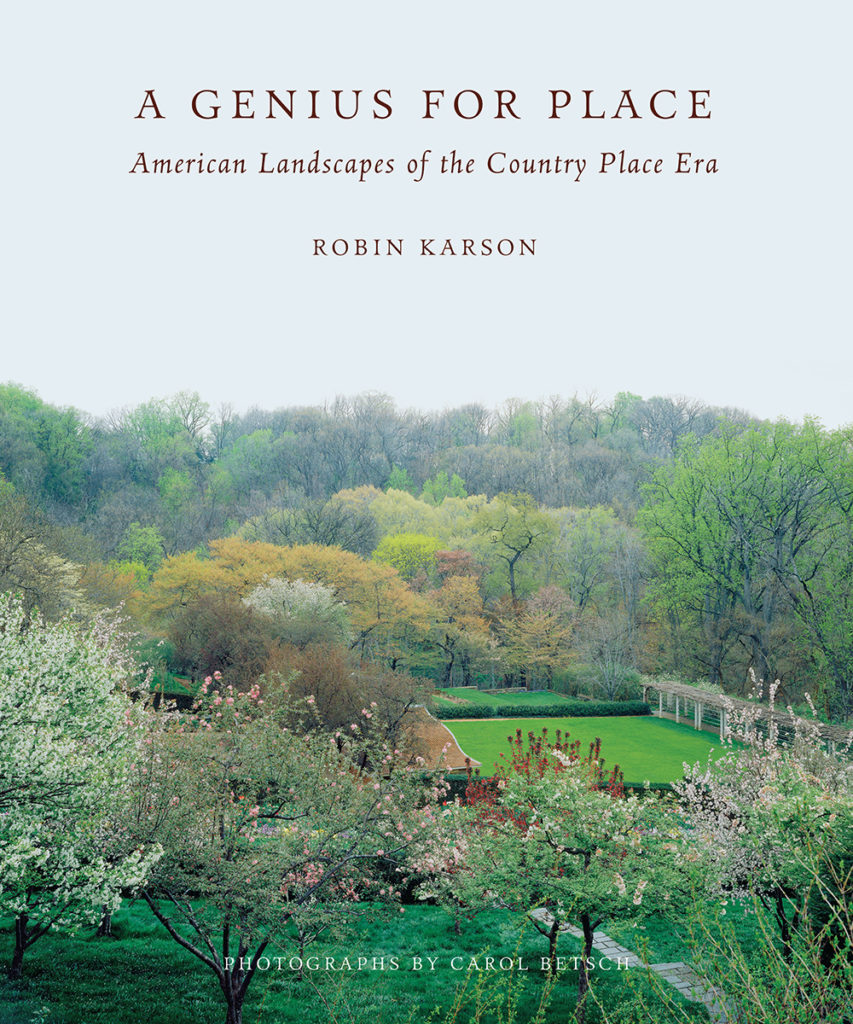A Genius for Place
American Landscapes of the Country Place Era
Robin Karson
Photographs by Carol Betsch
Library of American Landscape History
| ISBN: 978-1-952620-21-8 | 456 pages | 10 x 12 inches |
| $40.00 | Paper | Published: 08/27/2013 |
| 485 b&w photos and plans | |
In this lavishly illustrated volume, Robin Karson traces the development of a distinctly American style of landscape design through an analysis of seven country places created by some of the nation’s most talented landscape practitioners.
In the mid-nineteenth century Frederick Law Olmsted, the designer of New York’s Central Park, developed an approach to landscape design based on the principles of the English Picturesque which also emphasized a specifically American experience of nature and scenery. After Olmsted’s retirement in 1897, these precepts continued to ground a new generation of American landscape architects through the next four decades, a period known as the “country place era,” a time of rapid economic, social, and cultural change.
In the early twentieth century, new fortunes made it possible for wealthy Americans to commission country estates as a means of aggrandizing social status. These private havens also offered their owners respite from crowded cities and a way to preserve and celebrate places of distinctive landscape beauty. The commissions provided burgeoning numbers of landscape architects with opportunities to experiment with stylistic influences derived from Beaux-Arts, Arts and Crafts, and even Asian principles.
The chapters in this book trace a progression in the period from the naturalistic wild gardens of Warren Manning to the mysterious “Prairie style” landscapes of Jens Jensen to the proto-modernist gardens of Fletcher Steele. Other practitioners covered are Charles Platt, Ellen Biddle Shipman, Beatrix Farrand, Marian Coffin, and Lockwood de Forest Jr. The projects profiled follow a broad geographic arc, from Stockbridge, Massachusetts, to Santa Barbara, California. All seven landscapes are now open to visitors.
Analyzing these designs in context with one another and against the backdrop of the professional and cultural currents that shaped larger projects—such as parks, campuses, and planned communities—Karson creates a rich and comprehensive picture of the artistic achievements of the period. Striking black-and-white photographs by Carol Betsch capture the spirit of these country place landscapes today, and hundreds of drawings, plans, and period photographs illuminate their histories. These landscapes are also the subject of a photographic exhibition organized by LALH and hosted by museums throughout the U.S.
“Yet again Robin Karson has hit the ball out of the park. . . . In this book, as in her previous works, Karson redirects us toward our own homegrown antecedents. And we are that much richer for it.”
“Karson’s magisterial book shows the magnitude of the Country [Place] Era landscape heritage and confirms its importance as a major chapter in the history of American landscape design.”
“Analyzing these designs in context with one another and against the backdrop of the professional and cultural currents that shaped larger projects—such as parks, campuses, and planned communities—Karson creates a rich and comprehensive picture of the artistic achievements of the period.”
“Unlike literary masterpieces, even great landscapes are perishable, but each of the gardens Karson explores has survived the ravages of time, just as her book will, too.”
“What a feast Karson has spread before us! . . . The amalgam of people and places and their connections to each other make the book vastly interesting and lead us into novel insights on American social, cultural, intellectual, and even economic history.”
“This is an outstanding book . . . the best work I have read on the Country Place Era. Its selection of case studies focuses on the best designs of the period by the most talented individuals. . . . The writing is lucid, engaging, and witty.”
2008 Outstanding Title, University Press Books Committee
2009 J. B. Jackson Book Prize from the Foundation for Landscape Studies
About the Authors
Robin Karson
Robin Karson, Hon. ASLA, is the founder and executive director of LALH and the author of more than one hundred articles and several books on American landscape history, including (as coeditor) Warren H. Manning, Landscape Architect and Environmental Planner; A Genius for Place: American Landscapes of the Country Place Era; Fletcher Steele, Landscape Architect; The Muses of Gwinn, and the new introduction to the LALH revised edition of Fletcher Steele’s Design in the Little Garden. Her work has been recognized with awards from the American Society of Landscape Architects, the Foundation for Landscape Studies, the American Horticultural Society, and the Institute for Classical Architecture and Art. In addition, she has organized several touring exhibitions for LALH on topics relating to American landscape history. In 2004, Karson was named a distinguished member of the Honor Society of Sigma Lambda Alpha for her “continued high-quality contribution to the scholarship of landscape architecture and the literature of landscape architecture history.” In 2017, she was made an honorary member of the American Society of Landscape Architects.
Carol Betsch
Carol Betsch’s landscape photographs illustrate many LALH books, including A Genius for Place; Ellen Shipman and the American Garden; A World of Her Own Making; Henry Shaw’s Victorian Landscapes; Silent City on a Hill; and Warren H. Manning, Landscape Architect and Environmental Planner. Betsch is also managing editor of LALH.
